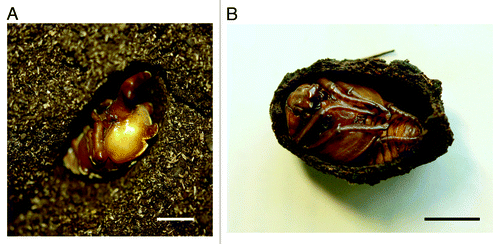Figures & data
Figure 1. Pupae and pupal cells of two Scarabaeidae species. (A) A male pupa of Trypoxylus dichotoma (Dynastinae) with a long head horn residing in a fragile cell. (B) A pupa of Dicronorhina derbyana (Cetoniinae) residing in a hard cell. Note that humus surrounding the cells was removed. Scale bar = 1 cm.

Figure 2. Interaction between pupae and larvae of Trypoxylus dichotoma. (A) A pupa in a pupal cell and a larva. The average distance between pupal cells and larvae was 6.4 cm in their natural habitat. (B) Oscillograms of vibrations produced by a male pupa in a pupal cell (upper) and vibrations produced by a foraging mole recorded by KC Catania (lower).Citation6 Arrows indicate the range used for playback experiments. (C) Proportion of larvae that broke artificial pupal cell(s) when pupal vibrations, background noise, or mole vibrations were played back. Sample sizes are shown in parentheses. NS: Not significant. ***p < 0.0003 by χ2 test with Bonferonni correction. (upper) are reproduced with kind permission of Springer Science+Business Media.
